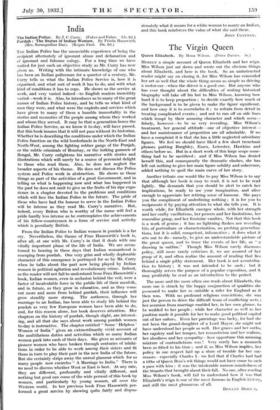THE Indian Police has the unenviable experience of being the
recipient alternately of ignorant abuse and defamation and of ignorant and fulsome eulogy. For a long time we have waited for just such an objective study as Mr. Curry has now given us. Writing with the intimate knowledge of one who has been an Indian policeman for a quarter of a century, Mr. Curry tells us what the Indian Police Service ,is, how it is organized, and what sort of work it has to do, and with what kind of conditions it has to cope. He shows us the service at work, and very varied indeed—to English readers incredibly varied—work it is. Also, he introduces us to many of the great names of Indian Police history, and he tells us what kind of men they were, and what were the exploits and services which have given to many of them a humble immortality in the stories and memories of the people among whom they worked and whom they served. It may be that a generation hence the Indian Police Service, as we know it to-day, will have passed. But this book insures that it will not pass without its historian. Whether he is describing the conditions under which the Indian Police function on the wild borderlands in the North-East and North-West, among the fighting robber gangs of the Punjab, or the subtle criminals of Bombay, or the lurking gunmen of Bengal, Mr. Curry enlightens his narrative with stories and illustrations which will surely be a source of perennial delight to those who read them. Also, he does not neglect the broader aspects of his theme. He does not discuss the Police system and Police work in abstraction. He shows us those things as part of the activities of a great Government, and in telling us what is happening now and what has happened in the past he does not omit to give us the fruits of his ripe expe- rience in a chapter devoted to the problems and conditions which will face the Indian Police in the future. The pride of those who have had the honour to serve in the Indian Police will be intense as they read Mr. Curry's narrative. But, indeed, every Briton who is worthy of the name will feel a pride hardly less intense as he contemplates the achievements of his fellow-countrymen in a form of service and activity which is peculiarly British.
From the Indian Police to Indian women in purdah is a far cry. Nevertheless, the theme of Frau Hauswirth's book is, after all, at one with Mr. Curry's in that it deals with one vitally important phase of the life of India. We are accus- tomed to hearing in these days that Indian womanhood is emerging from purdah. One very grim and wholly deplorable character of this emergence is portrayed for us by Mr. Curry when he talks about the part now being played by Indian women in political agitation and revolutionary crime. Indeed, as the reader will not fail to understand from Frau Hauswirth's book, Indian women, even in seclusion behind the veil, were a factor of incalculable force in the public life of their menfolk, and in future, as they grow in education, and as they come out more and more from behind purdah, their influence will grow steadily more strong. The authoress, through her marriage to an Indian, has been able to study life behind the purdah as very few European women have been able to do, and, for this reason alone, her book deserves attention. Her chapters on the history of purdah, though slight, are interest- ing, and all that she says about work among purdah women to-day is instructive. The chapter entitled " Some ' Helpless' Women of India " gives an extraordinarily vivid account of the multifarious duties and activities which so many Indian women pack into each of their days. She gives us accounts of pioneer women who have broken through centuries of inhibi- tions in order to be able to work among their sisters and fit them in turn to play their part in the new India of the future. But she certainly strips away the unreal glamour which for so many people now encircles " A Marriage to India." There is no need to discuss whether West or East is best. At any rate, they are different, profoundly and vitally different, and nothing but good can come of the wide perusal of this book by women, and particularly -by young women, all over the Western world. In her previous book Frau Hauswirth per- formed a great service by showing quite fairly and dispas-
sionately what it means for a white woman to marry an Indian, and this book reinforces the value of what she said there.
JOHN COATMAN.






























 Previous page
Previous page